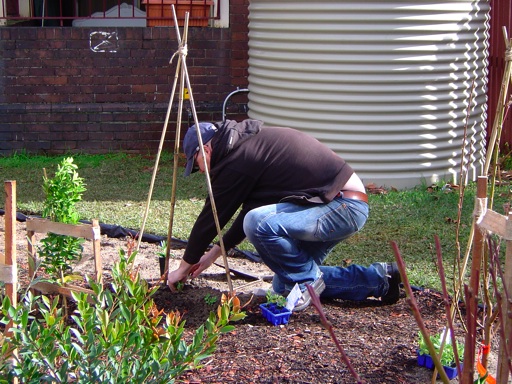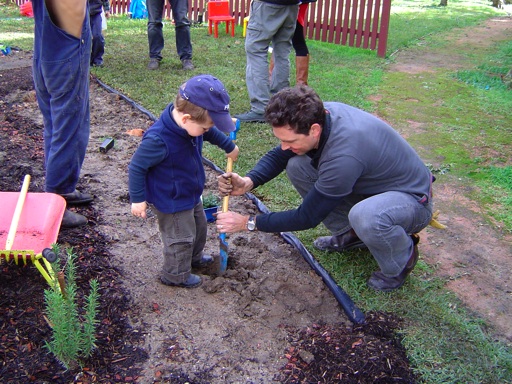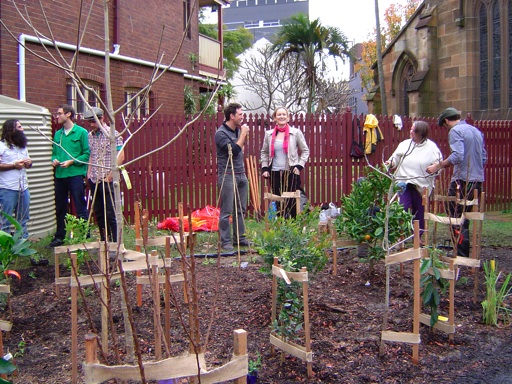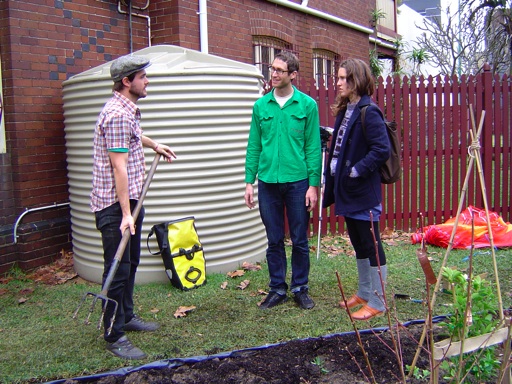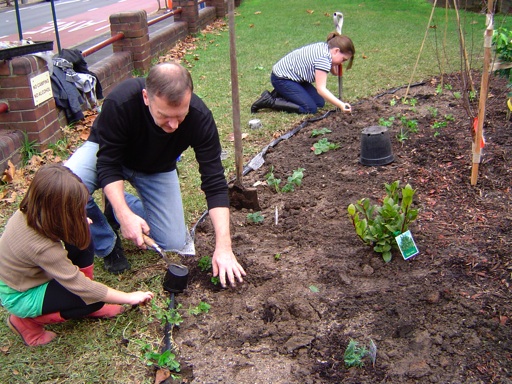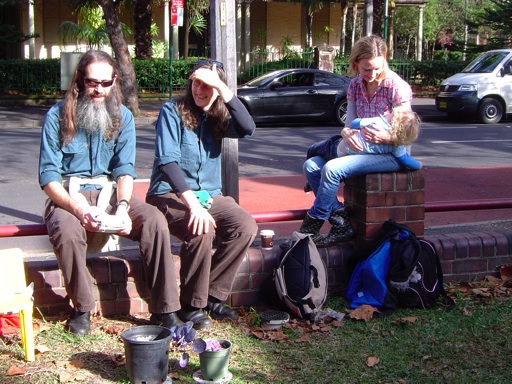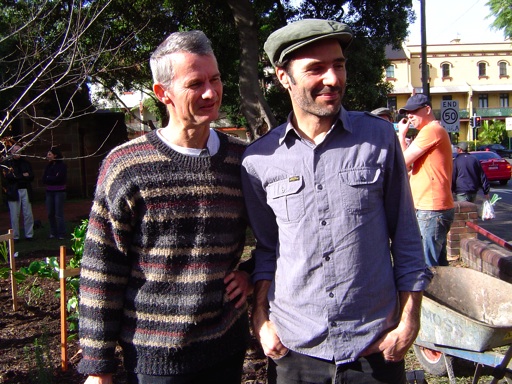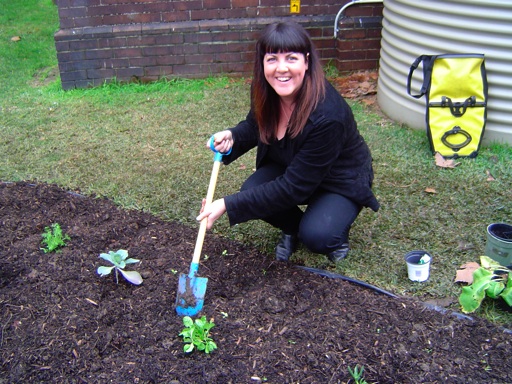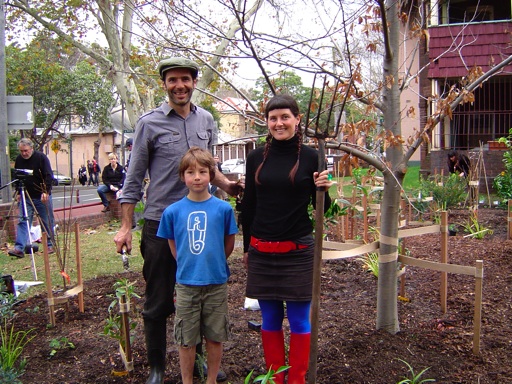Here's our five minute doco of the Food Forest install, accompanied by our home-brewed rock operetta. Enjoy!
Friday 30 July 2010
Tuesday 27 July 2010
Why we do what we do
1. Vandana Shiva
2. No matter how a person tries to frame or revise our culture there's no getting away from it – wealth delivers pollution.
3. Researchers tell us that the level of happiness peaks just above the poverty line, but we already knew this. Any accumulation of wealth after this point disables the adequate distribution of resources in order for local populations and ecologies to self-renew.
4. 32,000 people were treated last year in Australian hospitals for self-harming. The mental health of the country is flailing. An increasingly toxic food supply system is in part responsible. For a culture whose dominant ideology is based on a growth profit-pollution paradigm, figures like this will only increase.
5. The social and ecological costs of liberal growth economics should now be accounted. The world's elite impoverish life for everyone, especially the world's poor. An elite few are currently privatising the atmosphere to create the world's biggest commodity market – capitalising on pollution. This is sold as a solution – emissions trading and offsetting schemes – just as the Green Revolution was sold as a solution – privatised seeds and chemicals – for world hunger.
6. With ecological economics, community sovereignty of food, water and energy resources, and with permaculture principals you don't have to wait around for outmoded governments to reenter the real world; to understand soil microbes; to understand a just and sane way; to understand the profit-pollution paradigm; to understand the relationship between biodiversity and collective social health.
Thursday 15 July 2010
Key (draft)

Click for bigger
 Additional food planted on the first community plant-in day (the following plants relate to the areas on the drawing that we've labelled annuals and/or herbs):
Additional food planted on the first community plant-in day (the following plants relate to the areas on the drawing that we've labelled annuals and/or herbs):Annuals – a variety of brassicas, peas, nasturtiums and marigolds.
Perennials – native parsnip, lemon verbena, lemon grass, lavender, rosemary, pigface, dianella, rhubarb, thyme, mint, comphrey, whiteroot, Vietnamese mint and strawberries.
We would love to make this map of the food forest more interactive and web accessible. Any budding web designers out there interested in helping us?
Wednesday 14 July 2010
Reported
A big thanks to our national public broadcaster for their coverage of our project last Saturday night, 10 July. Our nephew/cousin Freddy and Iona, a Surry Hills resident whose mum coincidently lives in Daylesford, are featured beside the newsreader, Deborah Rice.
Food Forest on ABC TV from Patrick Jones on Vimeo.
There are a few mistakes in this reportage, namely the exclusion of the entire Artist as Family (Meg Ulman, Patrick Jones and Zephyr Ogden Jones); they spoke to Patrick and labelled him "Patrick White, Garden Artist"; and the church grounds where the forest is planted is St Michael's not St Stephen's, as reported.
Sunday 11 July 2010
Postpartum
One of the reasons we were attracted to St Michael's church as a site for the Food Forest is because they run a soup kitchen every Sunday morning. One of the aims for the Forest is that it will eventually supply organic fruit and vegetables to the kitchen.
We visited the kitchen this morning and shared a meal with the local residents who are all very excited about their community's new asset. This is the hall after we helped pack up, before we headed next door to the garden.
 We still had a few more things to do such as finish off mulching and say goodbye to our microbial friends in the soil, who it's been a privilege getting to know.
We still had a few more things to do such as finish off mulching and say goodbye to our microbial friends in the soil, who it's been a privilege getting to know.
 We then hammered stakes around the Forest's circumference and secured the bunting, which we won't remove until late August when the MCA show opens.
We then hammered stakes around the Forest's circumference and secured the bunting, which we won't remove until late August when the MCA show opens.
We then went round and drew a mud map of exactly what plants are where, which we will have engraved on a plaque to be displayed in the grounds, and available here online.
 We then dilly dallied. We took some more photos. We chatted to a few more passing residents about their hopes for the work. We sat down. We stood up. We chatted to the church congregation as they left their Sunday service.
We then dilly dallied. We took some more photos. We chatted to a few more passing residents about their hopes for the work. We sat down. We stood up. We chatted to the church congregation as they left their Sunday service.
And then it was time to go.
 Thank you so much to everyone who helped in making this work come about.
Thank you so much to everyone who helped in making this work come about.
And thank you to those whose enthusiasm and stewardship will ensure its future abundance.
We visited the kitchen this morning and shared a meal with the local residents who are all very excited about their community's new asset. This is the hall after we helped pack up, before we headed next door to the garden.
 We still had a few more things to do such as finish off mulching and say goodbye to our microbial friends in the soil, who it's been a privilege getting to know.
We still had a few more things to do such as finish off mulching and say goodbye to our microbial friends in the soil, who it's been a privilege getting to know. We then hammered stakes around the Forest's circumference and secured the bunting, which we won't remove until late August when the MCA show opens.
We then hammered stakes around the Forest's circumference and secured the bunting, which we won't remove until late August when the MCA show opens.We then went round and drew a mud map of exactly what plants are where, which we will have engraved on a plaque to be displayed in the grounds, and available here online.
 We then dilly dallied. We took some more photos. We chatted to a few more passing residents about their hopes for the work. We sat down. We stood up. We chatted to the church congregation as they left their Sunday service.
We then dilly dallied. We took some more photos. We chatted to a few more passing residents about their hopes for the work. We sat down. We stood up. We chatted to the church congregation as they left their Sunday service.And then it was time to go.
 Thank you so much to everyone who helped in making this work come about.
Thank you so much to everyone who helped in making this work come about.And thank you to those whose enthusiasm and stewardship will ensure its future abundance.
Saturday 10 July 2010
Many Hands
Friday 9 July 2010
Plant-In Preparation
We planted ten bare rooted fruit and nut trees today, including fig, mulberry, apricot, peach, nectarine, plum and almond.
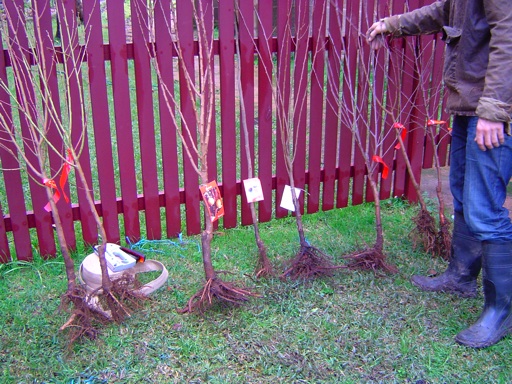 The ground was extra soft because of all the rain we have had, making the holes easy to dig.
The ground was extra soft because of all the rain we have had, making the holes easy to dig.
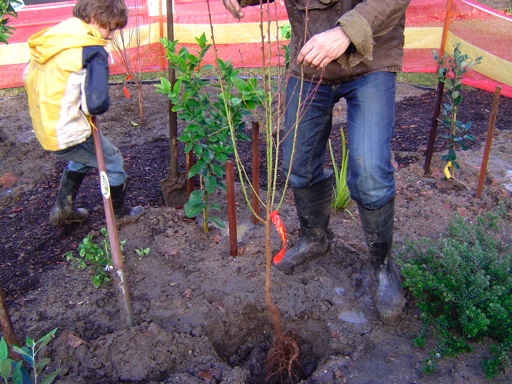 This is Richard and Heidi. We only found this ground at all because of Heidi. When we had the idea to plant a Food Forest, we had great difficulty finding some land. Heidi, a local resident heard we were looking and suggested we approach St Michael's. The rest, as they say, is history. In the making. Thank you, Heidi!
This is Richard and Heidi. We only found this ground at all because of Heidi. When we had the idea to plant a Food Forest, we had great difficulty finding some land. Heidi, a local resident heard we were looking and suggested we approach St Michael's. The rest, as they say, is history. In the making. Thank you, Heidi!
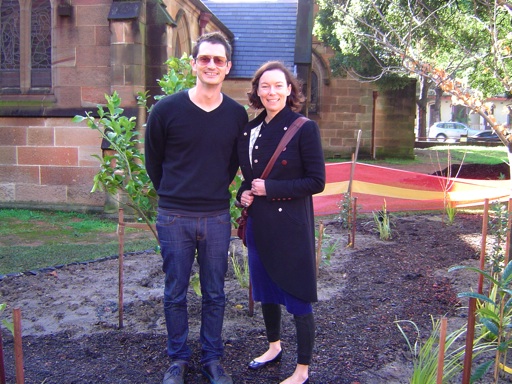 After saying goodbye to Heidi and Richard we spent a few hours mulching the Forest floor, leaving a meter around the periphery bare so people know where to settle their plants during tomorrow's Plant-In.
After saying goodbye to Heidi and Richard we spent a few hours mulching the Forest floor, leaving a meter around the periphery bare so people know where to settle their plants during tomorrow's Plant-In.
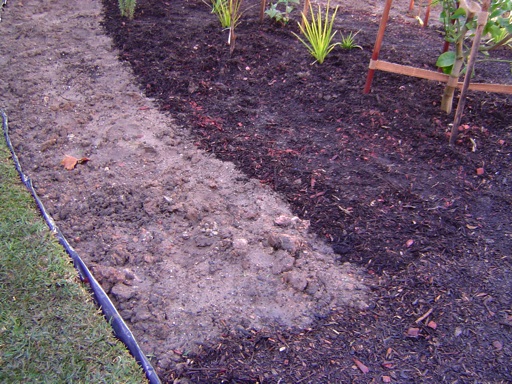 Just before lunch we went out to the Marrickville Community Nursery and picked up some Pigface, Whiteroot, Coastal Rosemary and native parsnip, which we are going to plant tomorrow in the Forest's outer ring.
Just before lunch we went out to the Marrickville Community Nursery and picked up some Pigface, Whiteroot, Coastal Rosemary and native parsnip, which we are going to plant tomorrow in the Forest's outer ring.
 So people can identify what's what, we then wrote each plant's name on a small copper tag and hung it on the corresponding tree.
So people can identify what's what, we then wrote each plant's name on a small copper tag and hung it on the corresponding tree.
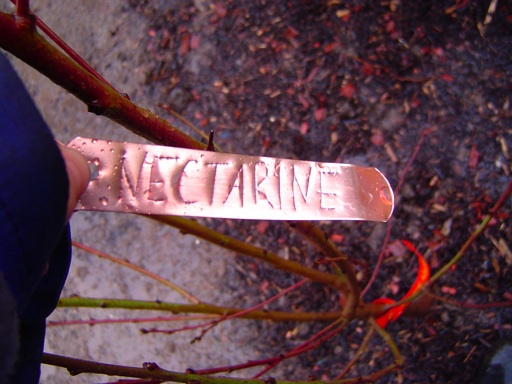
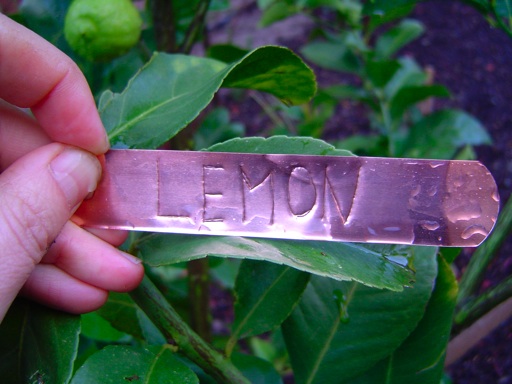 It's rained nearly every day we have worked on the Forest. But this afternoon's downpour was too heavy to work in, even for us Victorians. So it was tools down, and bottoms up at a hotel around the corner.
It's rained nearly every day we have worked on the Forest. But this afternoon's downpour was too heavy to work in, even for us Victorians. So it was tools down, and bottoms up at a hotel around the corner.
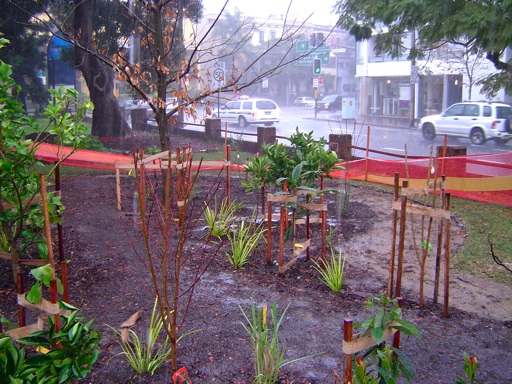 We will be on site tomorrow from 10am to 4pm come rain or shine. Come one and come all!
We will be on site tomorrow from 10am to 4pm come rain or shine. Come one and come all!
 The ground was extra soft because of all the rain we have had, making the holes easy to dig.
The ground was extra soft because of all the rain we have had, making the holes easy to dig. This is Richard and Heidi. We only found this ground at all because of Heidi. When we had the idea to plant a Food Forest, we had great difficulty finding some land. Heidi, a local resident heard we were looking and suggested we approach St Michael's. The rest, as they say, is history. In the making. Thank you, Heidi!
This is Richard and Heidi. We only found this ground at all because of Heidi. When we had the idea to plant a Food Forest, we had great difficulty finding some land. Heidi, a local resident heard we were looking and suggested we approach St Michael's. The rest, as they say, is history. In the making. Thank you, Heidi! After saying goodbye to Heidi and Richard we spent a few hours mulching the Forest floor, leaving a meter around the periphery bare so people know where to settle their plants during tomorrow's Plant-In.
After saying goodbye to Heidi and Richard we spent a few hours mulching the Forest floor, leaving a meter around the periphery bare so people know where to settle their plants during tomorrow's Plant-In. Just before lunch we went out to the Marrickville Community Nursery and picked up some Pigface, Whiteroot, Coastal Rosemary and native parsnip, which we are going to plant tomorrow in the Forest's outer ring.
Just before lunch we went out to the Marrickville Community Nursery and picked up some Pigface, Whiteroot, Coastal Rosemary and native parsnip, which we are going to plant tomorrow in the Forest's outer ring. So people can identify what's what, we then wrote each plant's name on a small copper tag and hung it on the corresponding tree.
So people can identify what's what, we then wrote each plant's name on a small copper tag and hung it on the corresponding tree.
 It's rained nearly every day we have worked on the Forest. But this afternoon's downpour was too heavy to work in, even for us Victorians. So it was tools down, and bottoms up at a hotel around the corner.
It's rained nearly every day we have worked on the Forest. But this afternoon's downpour was too heavy to work in, even for us Victorians. So it was tools down, and bottoms up at a hotel around the corner. We will be on site tomorrow from 10am to 4pm come rain or shine. Come one and come all!
We will be on site tomorrow from 10am to 4pm come rain or shine. Come one and come all!
Thursday 8 July 2010
Companions for a Polyculture
We had an organisational day today, so we were a little drier than we were yesterday. People have been contacting us to ask what plants would be best to bring on Saturday to the community plant-in. So if you too are wondering, here are a few suggestions:
As you can see below, the two internal zones (citrus, Cadigal and guava middle) and the upper canopy (large deciduous for winter light) are nearly complete, while the outer zone, the green pharmacy, will constitute the community 'plant-in' area.


Herbs such as basil (attracts butterflies), chervil, fennel, oregano, spearmint, dill and coriander (all repel aphids), sage, borage and hyssop (all attract honeybees), caraway (helps strawberries and attracts parasitic wasps), thyme, wormwood.
Flowers such as yarrow and tansy (both attract beneficial predators such as ladybugs and beetles), nasturtiums and marigolds (general all-rounders for attracting predatory insects).
Strawberries, rhubarb, Chilean guava and anything else that will grow in a semi-shaded position on the south-side of the garden. We are also requiring a few small hollow logs for lizards to inhabit.
As you can see below, the two internal zones (citrus, Cadigal and guava middle) and the upper canopy (large deciduous for winter light) are nearly complete, while the outer zone, the green pharmacy, will constitute the community 'plant-in' area.


Wednesday 7 July 2010
The Forest for the Trees
There was much activity on the corner of Albion and Flinders Streets today. Apart from all the rain and cloud action, we had trees and visitors aplenty.
Yesterday it seemed like an achievement to get two trees in the ground, today we planted considerably more, albeit somewhat smaller.
Here is one very special gardener with a very special delivery: olives, lemon verbena, rosemary, riberry and pecan.
 And dianella and lomandra longifolia, the latter whose leaves contain a fibre that can be used in basket-making, weaving and to make string. Their flowers can be eaten raw, or dried and ground to make a flour for dense cakes.
And dianella and lomandra longifolia, the latter whose leaves contain a fibre that can be used in basket-making, weaving and to make string. Their flowers can be eaten raw, or dried and ground to make a flour for dense cakes.
 We also planted a variety of citrus: grapefruit, mandarin, lime, lemon, orange and kumquat.
We also planted a variety of citrus: grapefruit, mandarin, lime, lemon, orange and kumquat.
 We also planted feijoas, coastal rosemary, lilly pilly, Brazilian guava, Hawaiian guava, avocados, lemon grass, loquat and cherimoya, which Mark Twain described as, "the most delicious fruit known."
We also planted feijoas, coastal rosemary, lilly pilly, Brazilian guava, Hawaiian guava, avocados, lemon grass, loquat and cherimoya, which Mark Twain described as, "the most delicious fruit known."
 With all the rain and planting the ground was getting pretty muddy, so we barrowed some mulch to make a path.
With all the rain and planting the ground was getting pretty muddy, so we barrowed some mulch to make a path.
 Then we cut down some trees and whittled them into stakes. Ha ha, not likely, although maybe one day the Forest will be abundant enough.
Then we cut down some trees and whittled them into stakes. Ha ha, not likely, although maybe one day the Forest will be abundant enough.
 We fastened some hessian tree-tie to them, to support and guard each plant.
We fastened some hessian tree-tie to them, to support and guard each plant.
 Just as the rain cleared, St Michael's Rev Francis Chalwell (right) came to say hello and introduce Bishop Alan Stewart.
Just as the rain cleared, St Michael's Rev Francis Chalwell (right) came to say hello and introduce Bishop Alan Stewart.
 And then a little later, Greens Senator, Scott Ludlam, Sustainable Cities portfolio, (right) and Tony Hickey, Greens candidate for the Federal seat of Sydney, (middle), came to see the Forest.
And then a little later, Greens Senator, Scott Ludlam, Sustainable Cities portfolio, (right) and Tony Hickey, Greens candidate for the Federal seat of Sydney, (middle), came to see the Forest.
 Dignitaries abounded, but the really very special guest was a visit by a beautiful native minor bird who danced around the oranges and had us entranced.
Dignitaries abounded, but the really very special guest was a visit by a beautiful native minor bird who danced around the oranges and had us entranced.
 As well as updating this blog with the Forest activity, we have been documenting the progress on digital film, which we will edit into a short piece a little later on. Watch this space.
As well as updating this blog with the Forest activity, we have been documenting the progress on digital film, which we will edit into a short piece a little later on. Watch this space.

Yesterday it seemed like an achievement to get two trees in the ground, today we planted considerably more, albeit somewhat smaller.
Here is one very special gardener with a very special delivery: olives, lemon verbena, rosemary, riberry and pecan.
 And dianella and lomandra longifolia, the latter whose leaves contain a fibre that can be used in basket-making, weaving and to make string. Their flowers can be eaten raw, or dried and ground to make a flour for dense cakes.
And dianella and lomandra longifolia, the latter whose leaves contain a fibre that can be used in basket-making, weaving and to make string. Their flowers can be eaten raw, or dried and ground to make a flour for dense cakes. We also planted a variety of citrus: grapefruit, mandarin, lime, lemon, orange and kumquat.
We also planted a variety of citrus: grapefruit, mandarin, lime, lemon, orange and kumquat. We also planted feijoas, coastal rosemary, lilly pilly, Brazilian guava, Hawaiian guava, avocados, lemon grass, loquat and cherimoya, which Mark Twain described as, "the most delicious fruit known."
We also planted feijoas, coastal rosemary, lilly pilly, Brazilian guava, Hawaiian guava, avocados, lemon grass, loquat and cherimoya, which Mark Twain described as, "the most delicious fruit known." With all the rain and planting the ground was getting pretty muddy, so we barrowed some mulch to make a path.
With all the rain and planting the ground was getting pretty muddy, so we barrowed some mulch to make a path. Then we cut down some trees and whittled them into stakes. Ha ha, not likely, although maybe one day the Forest will be abundant enough.
Then we cut down some trees and whittled them into stakes. Ha ha, not likely, although maybe one day the Forest will be abundant enough. We fastened some hessian tree-tie to them, to support and guard each plant.
We fastened some hessian tree-tie to them, to support and guard each plant. Just as the rain cleared, St Michael's Rev Francis Chalwell (right) came to say hello and introduce Bishop Alan Stewart.
Just as the rain cleared, St Michael's Rev Francis Chalwell (right) came to say hello and introduce Bishop Alan Stewart. And then a little later, Greens Senator, Scott Ludlam, Sustainable Cities portfolio, (right) and Tony Hickey, Greens candidate for the Federal seat of Sydney, (middle), came to see the Forest.
And then a little later, Greens Senator, Scott Ludlam, Sustainable Cities portfolio, (right) and Tony Hickey, Greens candidate for the Federal seat of Sydney, (middle), came to see the Forest.  Dignitaries abounded, but the really very special guest was a visit by a beautiful native minor bird who danced around the oranges and had us entranced.
Dignitaries abounded, but the really very special guest was a visit by a beautiful native minor bird who danced around the oranges and had us entranced. As well as updating this blog with the Forest activity, we have been documenting the progress on digital film, which we will edit into a short piece a little later on. Watch this space.
As well as updating this blog with the Forest activity, we have been documenting the progress on digital film, which we will edit into a short piece a little later on. Watch this space.
Tuesday 6 July 2010
The First Trees
We had another early start today. It was cold, so we all hooked in to the task of weeding, breaking up the clay, and preparing the ground for the first trees to be planted.
This is our friend Josh, who travelled up to Sydney to work with us on the Forest. Not only are you a gun with a shovel, Josh, but you're a great person to be around.
 This project may be credited to the Artist as Family, but there's no way we could do this without the help we have received from people such as Josh, Anna at the MCA, Rachel, whose lodgings we crash out in each night, our friends back home who have been ringing and emailing their support, and people we meet on a daily basis such as Owen.
This project may be credited to the Artist as Family, but there's no way we could do this without the help we have received from people such as Josh, Anna at the MCA, Rachel, whose lodgings we crash out in each night, our friends back home who have been ringing and emailing their support, and people we meet on a daily basis such as Owen.
This is Owen. Our two main trees arrived on the back of his truck this morning.
 Here comes the Spanish Chestnut. At 5 meters in height, she makes a very grand entrance and is carefully steered into her place at the head of the Forest.
Here comes the Spanish Chestnut. At 5 meters in height, she makes a very grand entrance and is carefully steered into her place at the head of the Forest.
 Next up comes the Indian Horse Chestnut, generously donated by Michael Pfhal at Treekeepers Nursery, Bowral, NSW, who also grew the Spanish.
Next up comes the Indian Horse Chestnut, generously donated by Michael Pfhal at Treekeepers Nursery, Bowral, NSW, who also grew the Spanish.
 In an attempt to prevent the untiring couch grass from taking over the forest floor, we have weeded out every last skerrick of root and leaf, and today, laid black plastic in a trench around the periphery of the Forest as a barrier.
In an attempt to prevent the untiring couch grass from taking over the forest floor, we have weeded out every last skerrick of root and leaf, and today, laid black plastic in a trench around the periphery of the Forest as a barrier.
 The couch grass may be indefatigable, but we mere mortals are not.
The couch grass may be indefatigable, but we mere mortals are not.
 Sleep well chestnuts! See you on site in the morning.
Sleep well chestnuts! See you on site in the morning.
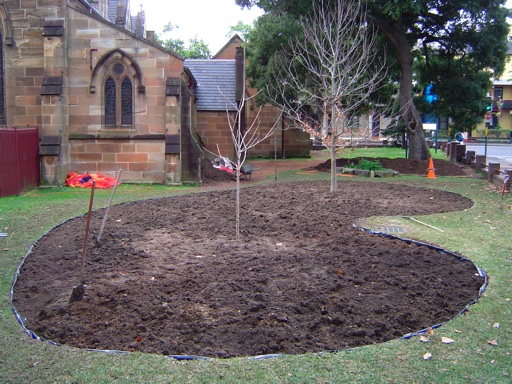
This is our friend Josh, who travelled up to Sydney to work with us on the Forest. Not only are you a gun with a shovel, Josh, but you're a great person to be around.
 This project may be credited to the Artist as Family, but there's no way we could do this without the help we have received from people such as Josh, Anna at the MCA, Rachel, whose lodgings we crash out in each night, our friends back home who have been ringing and emailing their support, and people we meet on a daily basis such as Owen.
This project may be credited to the Artist as Family, but there's no way we could do this without the help we have received from people such as Josh, Anna at the MCA, Rachel, whose lodgings we crash out in each night, our friends back home who have been ringing and emailing their support, and people we meet on a daily basis such as Owen.This is Owen. Our two main trees arrived on the back of his truck this morning.
 Here comes the Spanish Chestnut. At 5 meters in height, she makes a very grand entrance and is carefully steered into her place at the head of the Forest.
Here comes the Spanish Chestnut. At 5 meters in height, she makes a very grand entrance and is carefully steered into her place at the head of the Forest. Next up comes the Indian Horse Chestnut, generously donated by Michael Pfhal at Treekeepers Nursery, Bowral, NSW, who also grew the Spanish.
Next up comes the Indian Horse Chestnut, generously donated by Michael Pfhal at Treekeepers Nursery, Bowral, NSW, who also grew the Spanish. In an attempt to prevent the untiring couch grass from taking over the forest floor, we have weeded out every last skerrick of root and leaf, and today, laid black plastic in a trench around the periphery of the Forest as a barrier.
In an attempt to prevent the untiring couch grass from taking over the forest floor, we have weeded out every last skerrick of root and leaf, and today, laid black plastic in a trench around the periphery of the Forest as a barrier. The couch grass may be indefatigable, but we mere mortals are not.
The couch grass may be indefatigable, but we mere mortals are not. Sleep well chestnuts! See you on site in the morning.
Sleep well chestnuts! See you on site in the morning.
Subscribe to:
Posts (Atom)



